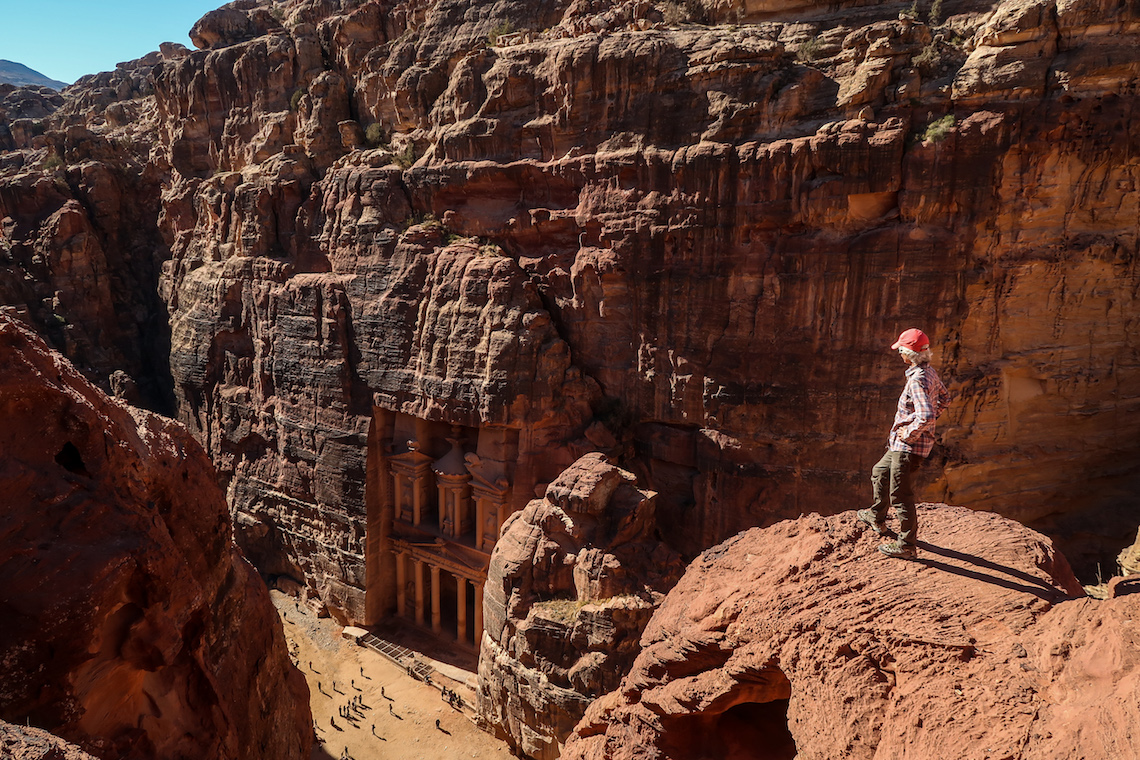With 400 miles of beautifully varied walking, the newly-created Jordan Trail is set to become one of the world’s classic long distance walks. Having walked the entire thing, Karin-Marijke Vis looks back on some of her favourite moments…
Our last breakfast. Our last packing session. Our last hoisting of the packs. Our last of everything. I didn’t want to think about it, yet was more aware of my actions than on any of the previous 33 days of hiking. “Can we turn around in Aqaba and walk back to Umm Qais,” I asked Coen, my partner.
I had enough energy to walk the entire 400 miles back to the head of the trail, although my feet did demand a rest. They were hurting, but I didn’t want our epic adventure to end. I felt I could walk forever through this timeless landscape that had captured my heart and where it had been so easy to tune into the rhythms of nature. Fortunately, we hadn’t reached the end yet, for we had another five miles to go.
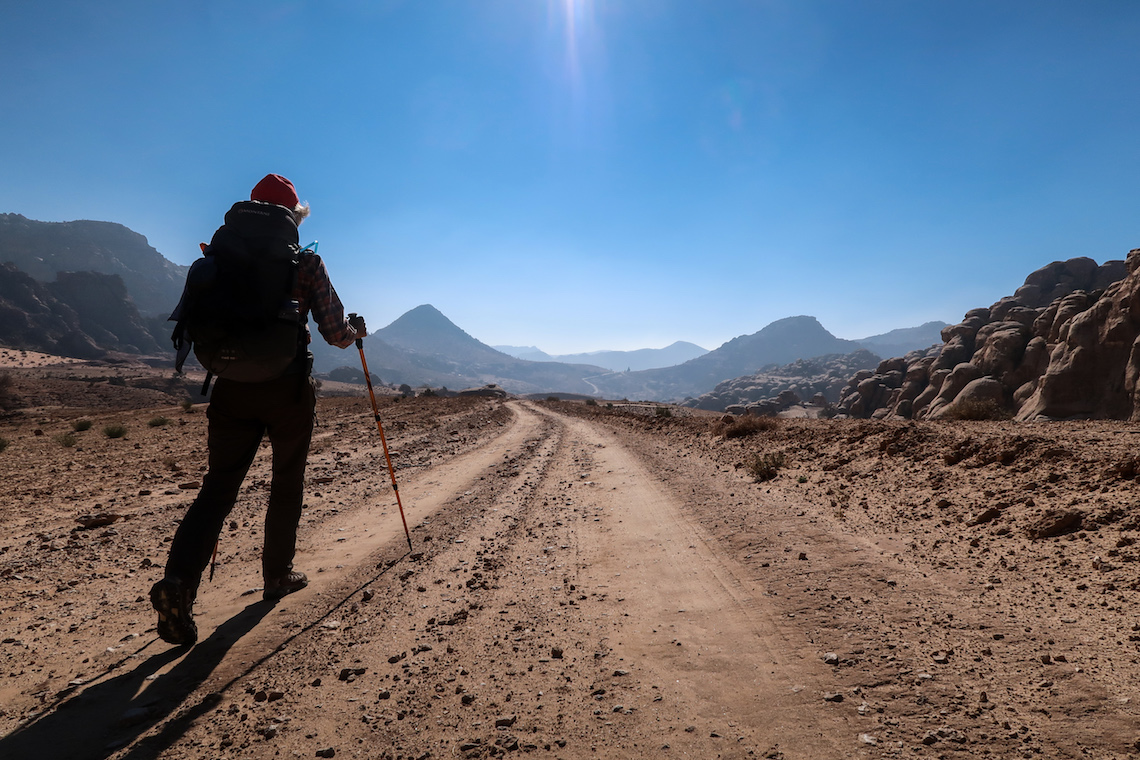
We entered our last narrow gorge, where we clambered over and around dark and light grey boulders. On the other side of the canyon it was easy going over uninspiring, gravel trails. In the distance we saw our final destination: the Gulf of Aqaba shimmering in the heat haze with the vague contours of a containership.
“What was your favourite section?” I asked Coen, attempting to block out the sight of the finish and keep my mind on the trail a bit longer. “Well, let me see…”
The Jordan Trail
I asked myself the same question, and while our feet steadily tramped the ground we both got lost in thought. Through my mind flashed images of Bedouins holding up their black-sooted teapot, signalling for us to “come drink tea”. Kids with mules drawing water from a well. Walking across sherds of pottery outside Petra, the dried clay crunching underfoot. Struggling to prevent our tent from being blown away when a dust storm hit. Coen getting up in the middle of the night to reinforce the lines as the storm gained strength. Feeling fortunate, rich and free with all I needed on my back hiking down Wadi Mujib. Jordan’s version of the Grand Canyon is a wide, colourful and barren valley so vast, it rang in my ears. The images were endless and were all part of the 400-mile Jordan Trail we were about to complete.
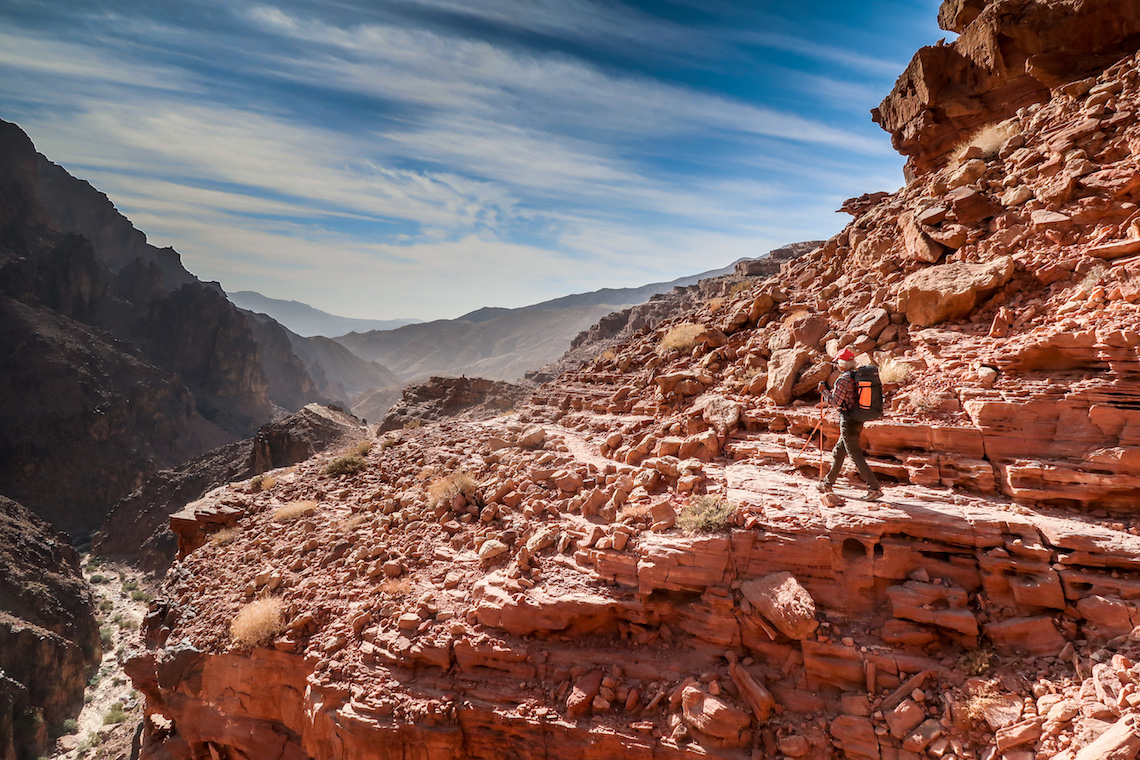
A young country on paper (since 1946), Jordan’s land is ancient. It has been inhabited since Palaeolithic times and for centuries was a crossroads for traders, pilgrims and migrants travelling from east to west and from north to south. Civilisations rose and fell, many of them built on top of each other growing into tells or mounds that are treasure troves for archaeologists.
In the 1990s, while working on a guidebook about hiking in Jordan, the veteran British mountaineering couple Tony Howard and Di Taylor came up with the idea to create a long-distance hike spanning the length of the country, based on the Abraham Trail that connects Syria, Jordan and Israel. The seed needed time to mature, but in 2015 the Jordan Trail Association (JTA) was formed and thanks to volunteers, local hiking groups, Bedouin tribes, grants and donations, the Jordan Trail was officially opened in the spring of 2017.
By chance, we met one of the initiators and organisers on the night prior to our departure from Umm Qais, the northernmost point of the trail. Muna Haddad is one of the founders, as well as president of the JTA. She explained how the route had been designed to offer opportunities for ‘everybody’. For locals and foreigners alike to have an adventure; for foreign visitors a unique way of connecting with local people, culture and lifestyles; and for owners of accommodation, local guides and other locals a share in the economic benefits of Jordan’s tourism industry.
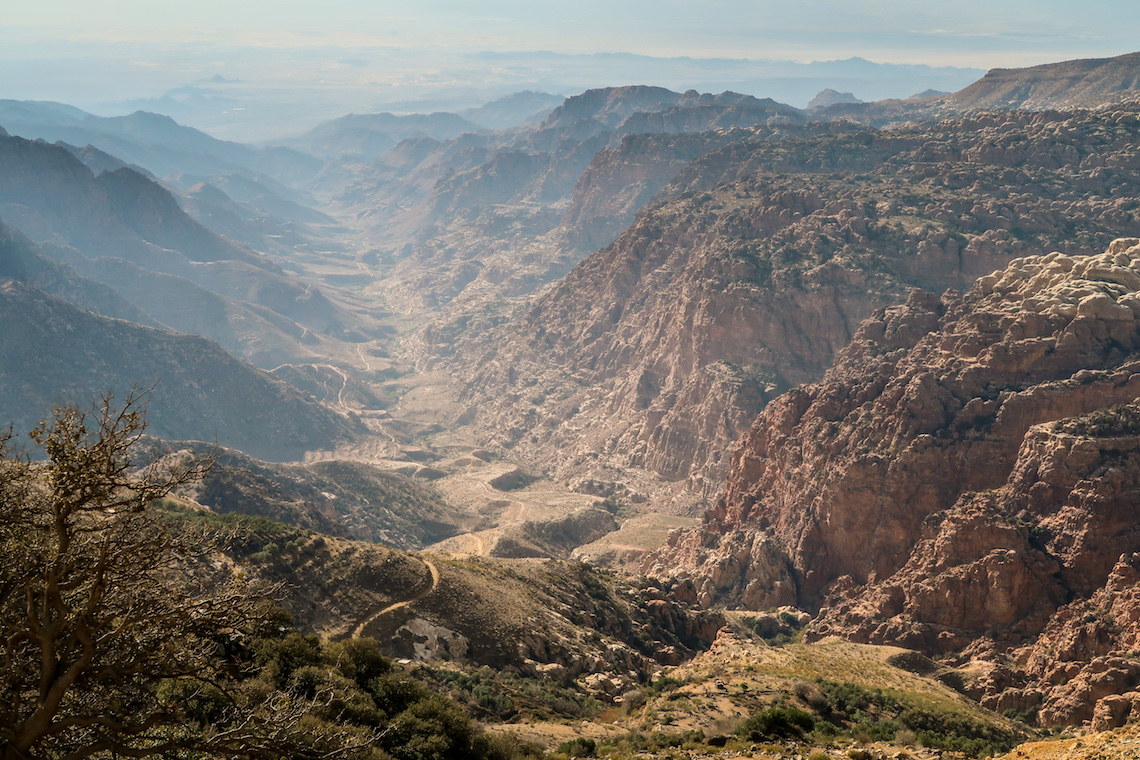
In the north the trail meanders through fertile lands covered with olive groves and agricultural fields growing pulses and barley. The hills and valleys are dotted with Greco-Roman ruins and biblical places, such as Mount Nebo from where Moses gazed out over the Promised Land. The scenery changes into red and orange-tinged rocks, canyons and wadis (valleys) that cut through the country from east to west, their high plateaus offering views of the Dead Sea. In the south lie the wondrous ruins of Petra and the vast Martian-looking landscape of Wadi Rum. The entire trail passes through some 50 villages and towns, providing plenty of opportunities to stock up on supplies. “The Day of the Bedu Cha,” Coen interrupts my thoughts.
When writing my diary, I had given each day a name, one that summarised in a few words what the day had been about. The Day of Scorpions, the Day of Miscommunication, of Sore Feet, of Good Company – enough to transport me back to a certain day, encounter or mishap.
The Day of the Bedu Cha
This particular day pretty much sums up what the Jordan Trail is about. Apart from mind-blowing landscapes and a rich heritage in historic sites, what most hikers are most likely to remember is Jordan’s incredible culture of hospitality. All along the trail you may come across people who invite you for coffee, lunch or to spend the night in their home. The Day of the Bedu Cha was about tea (‘cha’) in the southern part of the country, home to Bedouins (locally called ‘Bedu’).
That day we got up at around five, as usual. We were hiking in winter (December/January), when the sun sets around five. If we wanted to get some decent hours of hiking done in a day, getting up early was requisite, even though it was still dark. The advantage of winter was that it was never too hot to hike. While Coen prepared tea and oatmeal with raisins, I packed our bags. Our bellies full, we hoisted our packs and, for a couple of hours, walked along red-orange rocks and through siqs, narrow gorges with curving, vertical walls of polished stone. To exit the canyon we climbed through sifting sand, where shepherds watched us as their goats and sheep foraged on tufts of vegetation that grew on barren slopes.
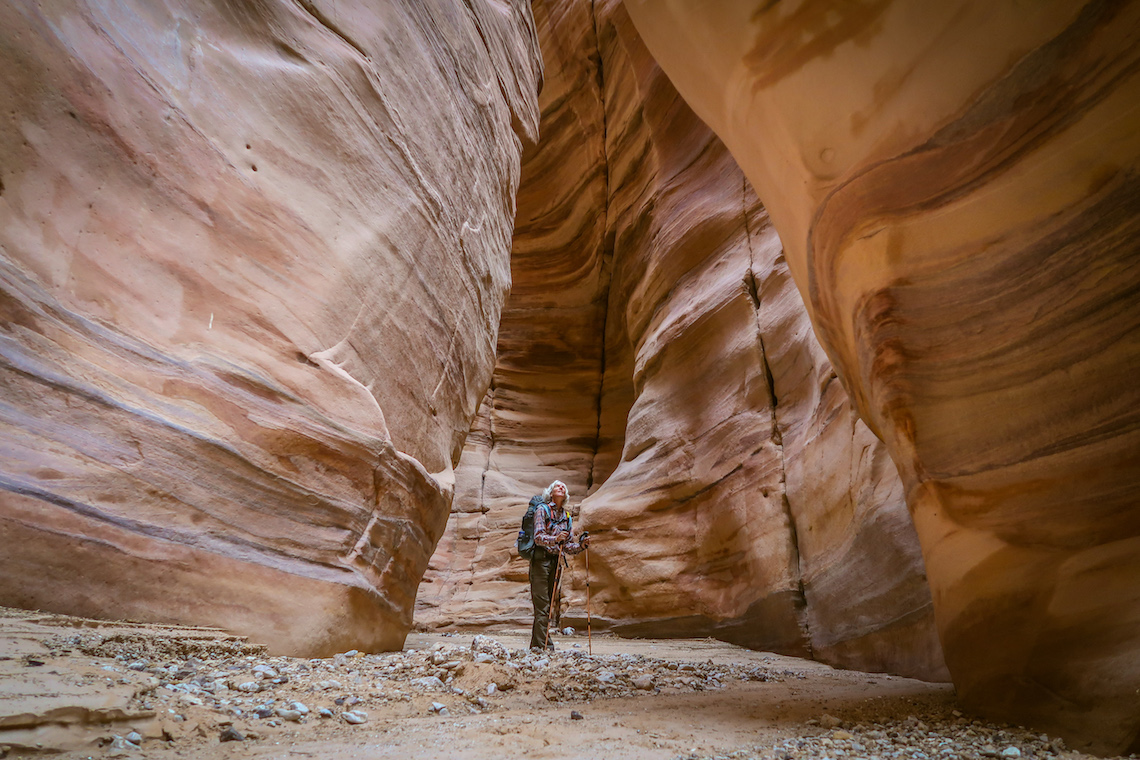
The trail became a 4×4 road that cut through a vast expanse of desert hemmed in by mountains on the horizon. A dot in the distance materialised into a man sitting on his haunches on a rock along the side of the road. As we neared him, he stood up, his hand stretched out for a hearty handshake. “I am Abu Sabuk. Come, drink tea with me,” he offered. Off to the side stood a big, black goat-hair tent. Inside we sat down on rattan mats. Next to the fireplace in the centre, a young man was kneading bread in an aluminium bowl, folding it into a thick round shape which he baked in the hot sand of the fireplace.
Kids gathered with cheery greetings – Ahmed, Mohamed and Jesse. Abu instructed them to take some steel boxes from the shelves along the side of the tent. “Look, my pictures.” There were about 100 photos, old and crumpled, of camels and tourists – the latter mostly women. When tea was served, prepared by women out of sight, I shared our brioches and we talked about the hike. It was tempting to stay, nice and warm and in good company, but after two cups of tea we said our goodbyes. If we had given in to all these temptations we would still be in Jordan.
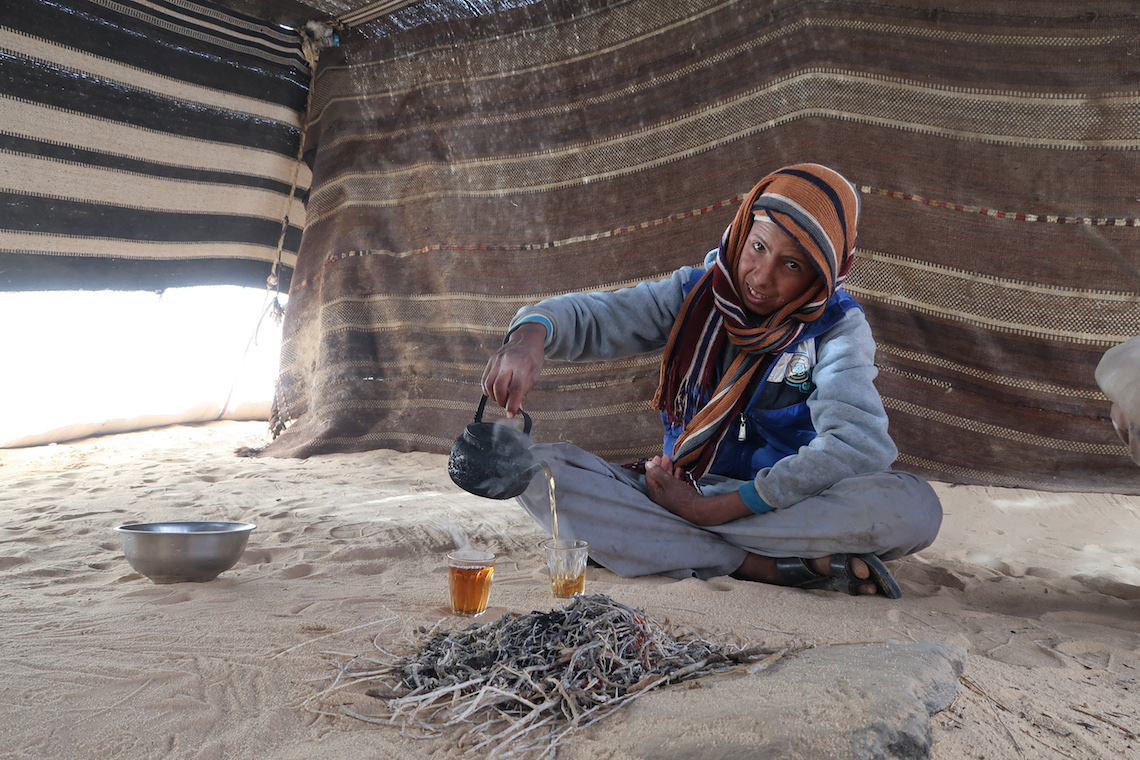
In the distance resonated gunshots that came from either the Israelis practising on the other side of the border or from the Jordan military who were running a military base nearby. We meandered among the ruins of Humeina, a village long abandoned. An attempt had been made to make it into a tourist site, including a visitors’ centre. It was closed, the panels unreadable, and no water to be had. What was this place, and why had this initiative failed? There was no one to ask.
For miles on end we were dots in a vast expanse of nothingness with some low shrubbery, exactly one tree, and lots of fist-sized burrows. What animals lived in them? We spotted two camels, a mother and young. A bit further on dogs were tied to bushes and started barking as we approached. Behind a hill stood a Bedu tent partly covered in plastic sheets that once served as 25 or 50kg bags for dried foods or coffee beans. A young man emerged. “Cha, cha, welcome,” he beckoned. We were ushered into an empty section, but for a rattan mat that was immediately rolled out, and twigs were put at the ready to be lit for a small fire.
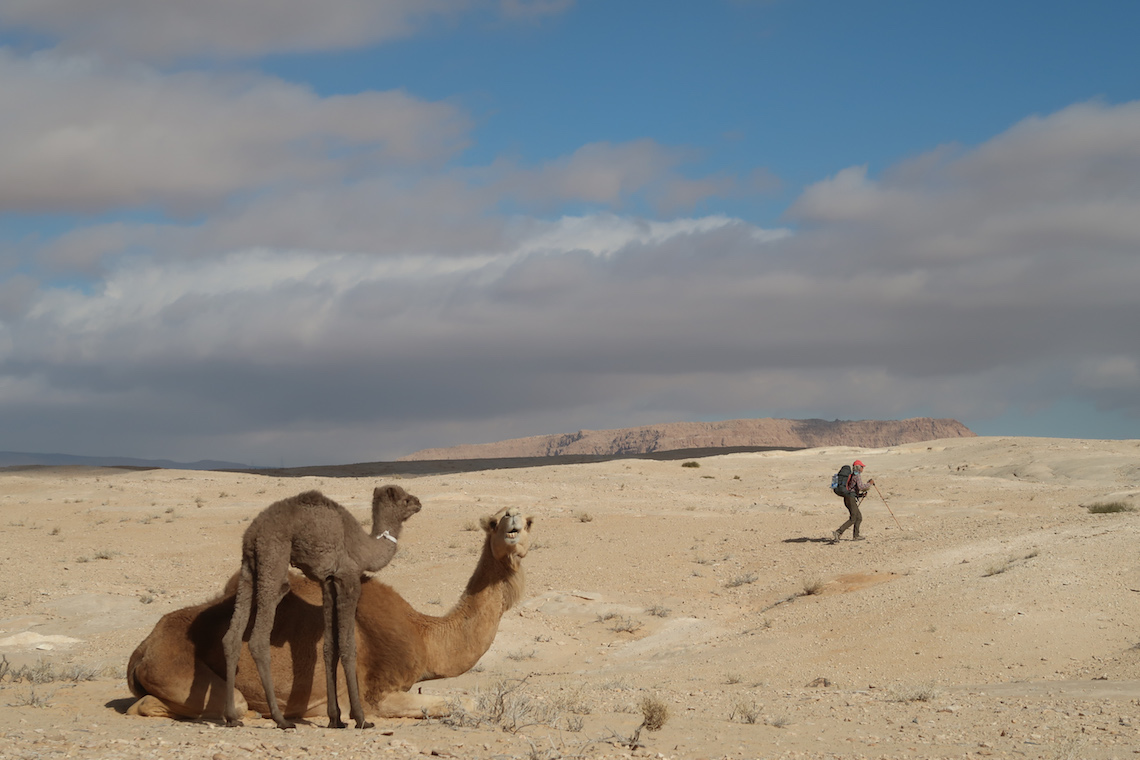
We sat down, crossing our legs, while the young man Saiga returned with a bowl of water, holding it in front of us. I let him sprinkle water over my hands to clean dust off them, as did Coen. Saiga lit the fire, but there was no teapot. We were lost as to what was happening and waited quietly, taking in the super clean area. Two little boys entered, Omar and Simar, who didn’t speak English. Coen swiped through images on his smartphone to find some topics of conversation – the 21st-century version of postcards and printed photos from our home country. A man arrived, clearly summoned to entertain these foreign guests. He took off his shoes and socks, and used the bowl with water to wash his feet and hands. The language in mime continued in between sipping syrupy sweet tea that had meanwhile arrived from behind a curtain, the heavy dose of sugar welcomed by our fatigued bodies.
In the meantime, two women were peeking through the curtain. I gesticulated with my hands, asking if I could say hi to them. When I walked up to them, they ran to the back. After three more curtains I arrived in the kitchen with a fireplace and a rack with shelves containing a handful of pots and pans. The girl was dressed in pink and curiosity fired from her eyes. The woman didn’t dare to look me in the eye, but did shake my hand. What were their stories?
We said our goodbyes and continued to the town of Humeina, ready for a good meal and to stock up. Across a dune we suddenly found ourselves transported from ancient lands into the 21st century. A highway (from Aqaba to Amman) divided the modern town with its concrete, flat-roofed houses into two halves. Further down, massive power lines were strung out across the red-sand desert. In a small supermarket we picked up Snickers, cucumber, water and bread from the minimally stocked shelves. Ready for a big meal, we were disappointed to find there were no restaurants. Our best treat was a freshly prepared cup of Turkish coffee enhanced with cardamom.
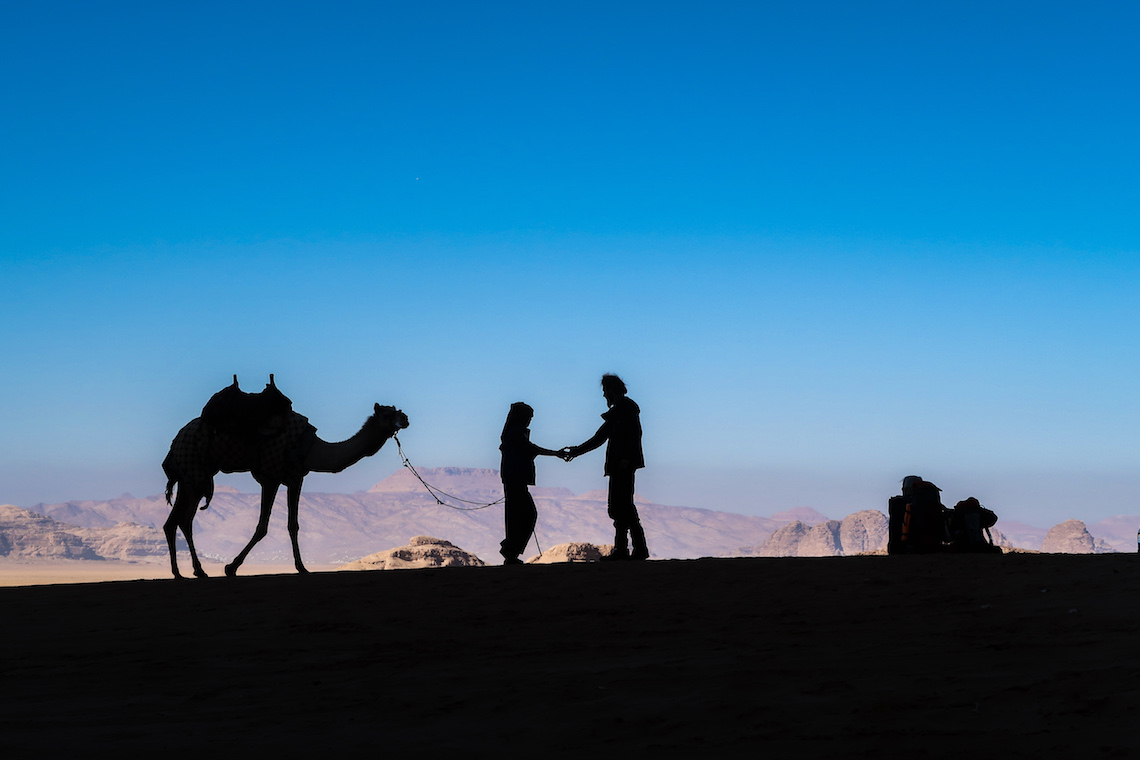
We returned to the wide sweeps of sand, our packs now heavy with food for a couple of days. The thundering trucks on the highway hurt our ears, our bodies, and our systems that had grown so used to silence. On the other side of the road were more Bedu tents, and men motioned us to come closer. “Have tea with us,” they offered. Inside, it was warm and cosy. We had not realised yet how cold the fierce wind had become at an elevation of 900m and the sun would soon set. A big fire of roots dug up in the desert roared in the fireplace as we sat on rattan mats around it and the men smoked a shisha, water pipe.
They warned about bad weather. Snow and storm, they said, while tea was brought in from behind the curtain. The men worked in tourism, driving tourists around in four-wheel drives or on camels. They took out their smartphones and showed photos of female tourists. We said goodbye and walked the last two miles of the day deep into the lunarscape, away from the bustle and noise. Behind a rock, we found a bit of shelter and pitched our tents in the late afternoon sun, which was turning the desert into golden and orange tinges. With threatening dark grey clouds in the background, the scenery was breathtaking. It turned out to be one of our most beautiful camping spots, with a pitch-black sky at night cut through by the Milky Way.
The Day of Regretting that it’s Over
My thoughts were catapulted back to today, when a car was honking its horn, overtaking me. The wilderness was behind us and the roadsides were packed cheek by jowl with restaurants, hostels and coffee bars visited by tourists in bikinis.
On the beach, we walked to the shore. With our toes touching the water we stared out over the blue waters, feeling proud of what we had accomplished. Already a sentiment of nostalgia was washing over me, even before the trail had truly become part of our past. That evening I would give a name to this last day of our 33-day, 400-mile Jordan Trail: The Day of Regretting that it’s All Over.
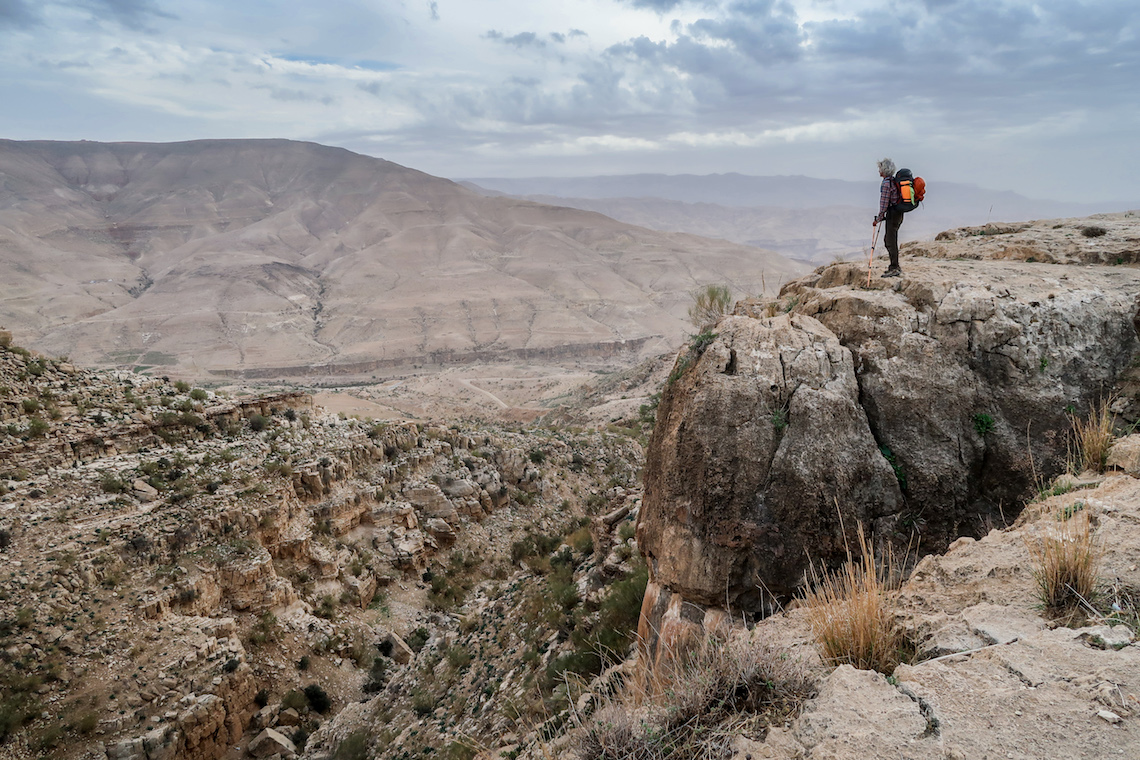
The Jordan Trail: How to conquer it yourself
How to get there
The Jordan Trail is normally walked from Umm Qais, in the north, to Aqaba, in the south. One-way fares to Amman from London can be had for a little over £300, while a flight home from Aqaba is available with easyJet from the start of November until spring, with prices hovering just under £100 at the time of writing.
When to go
Spring and autumn represent good times to visit Jordan, as daytime temperatures typically hover in the 20Cs and the nights are cool. You might also consider travelling into the winter months, during which time the higher elevations may experience freezing temperatures and snow, while rain and high wind are also more frequent.
What to take
As this is a multi-day hike, you’ll need to pack accordingly. Most important of all is to have a large rucksack (at least 50L in size, depending on the time of year you’re travelling and how light you pack) and decent walking boots that have both been worn in well.
Take light layers with you so you can react to the wide range of temperatures you are likely to experience. It is important that they cover your shoulders and knees to respect the conservative nature of the country. We’d recommend using natural fibres such as merino wool for their warmth-to-weight ratio and anti-bacterial properties. Warmer layers are necessary for higher elevations and evenings.
If you intend to wild camp, you will also need to bring your camping set up, but we’d recommend going as lightweight as you can possibly afford. Camping gas is not widely available throughout Jordan, so a multi-fuel stove is your best bet in this regard. You’ll also need to take a lot of water with you each day too (organisers of the Jordan Trail recommend five litres per day). Speaking of which, it is worth taking water purification tablets or technology to treat any water supplies you need to rely on while walking. You’ll find a more exhaustive list of recommended kit on the Jordan Trail website.
Where to stay
A mix of home stays, hotels and campsites line the Jordan Trail, while wild camping is also possible at various points.
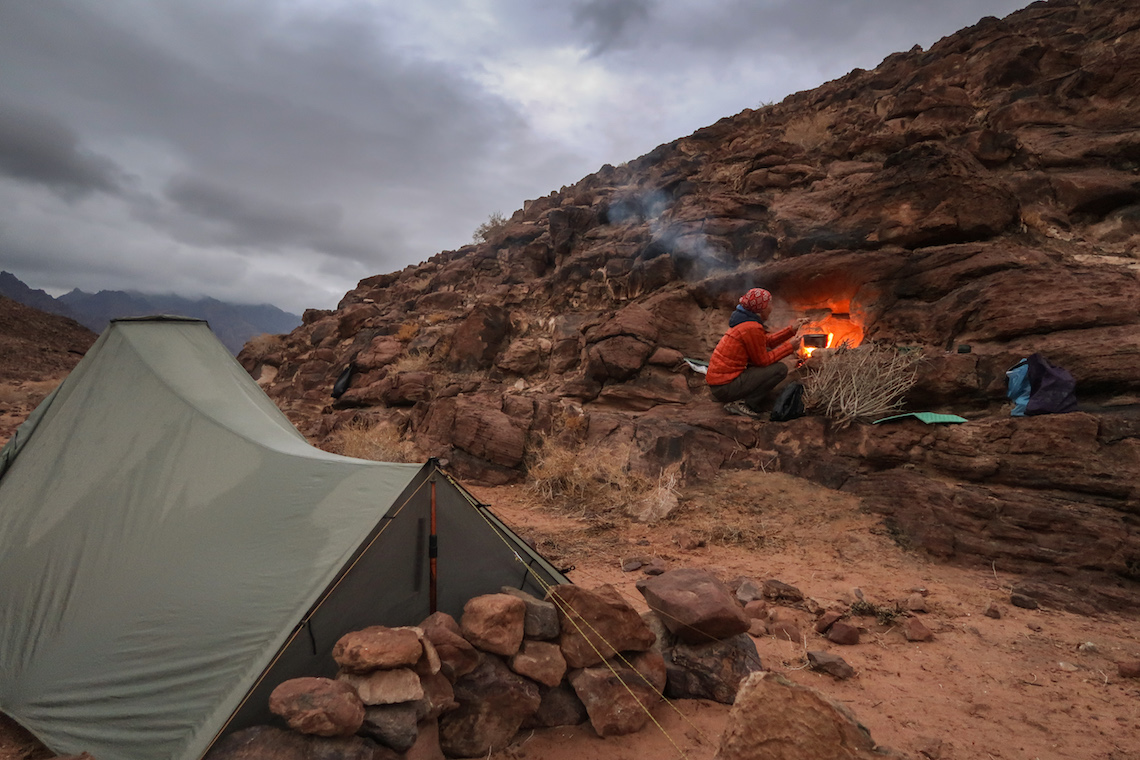
Find out more
Head to the official Jordan Trail website for detailed information on the route, accommodation options, food and drink availability, safety tips and recommended stops.



